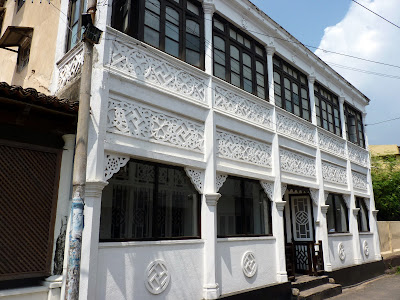 |
| View from ramparts of mosque and lighthouse |
Our guidebook explains that Galle is the fourth largest city in Sri Lanka, but that's difficult to believe wandering the sleepy streets of the old town. Some believe that Galle is the ancient city of Tarshish, where King Solomon obtained gems, spices, peacocks and ivory. The city's modern history started in 1505, when a Portuguese ship inadvertently discovered the town after being blown off course by a storm on its way to the Maldives. The town's residents refused to let the Portuguese enter, so the Portuguese took it by force. The Portuguese eventually were themselves forced to surrender the town to the Dutch, who built a large seaside fort in the 1660s. The city reached its prominence during the Dutch colonial period, serving as the island's major seaport and an important stopover for ships traveling between Europe and East Asia. But after the British took control in the late 18th century, over time Galle decreased in importance as Colombo became Sri Lanka's major seaport and trading center.

The Dutch fort remains mostly intact to this day, with large walls and bastions overlooking the sea. Galle deservedly has become a prime tourist destination, known for its wealth of colonial architecture, its numerous historical sights, its dramatic setting surrounded on three sides by the Indian Ocean, its broad range of accommodations (from stylish boutique hotels to small, unassuming guesthouses), its delicious home-cooking, and its inviting, laid-back vibe. The newer parts of Galle suffered significant damage and loss of life as a result of the 2004 tsunami, but the Dutch fortifications protected the old town from harm.

Galle is a great place to wander around for a few days to soak up the atmosphere and explore Sri Lanka's Dutch and English colonial history. (But don't look for anything Portuguese, as the Dutch long ago destroyed any remnants of their presence.) Even aside from the distinctive colonial architecture, the old town has a unique feel for Sri Lanka, as it houses a substantial population of Muslims, many of whom are descendants of Arab merchants who settled here over the centuries. One of the old city's landmarks is a whitewashed seaside mosque, which was initially built as a church. Another is an old lighthouse, where you can descend the ramparts for a swim in the Indian Ocean. Although the small, rocky beach can't compare to the sweeping, palm-fringed strip of white sand in Mirissa, here there were only locals swimming whereas in Mirissa there were only foreigners. And unlike many historical sights, with abandoned ruins that are divorced from the local population, the fort in Galle continues to house a living community - albeit one increasingly devoted to tourism.
Galle is a must on any Sri Lankan tourist itinerary. Just be careful walking along the ramparts with your adventurous young children, as there no guardrails or warning signs to protect against grievous gravity-related injuries....
 |
| "Don't back up!" (Just kidding, there's land behind there. I think.) |
 |
| At our guesthouse |
 |
| Formerly a church, now it's a mosque |
 |
| View of Buddhist temple from the ramparts |
















































No comments:
Post a Comment